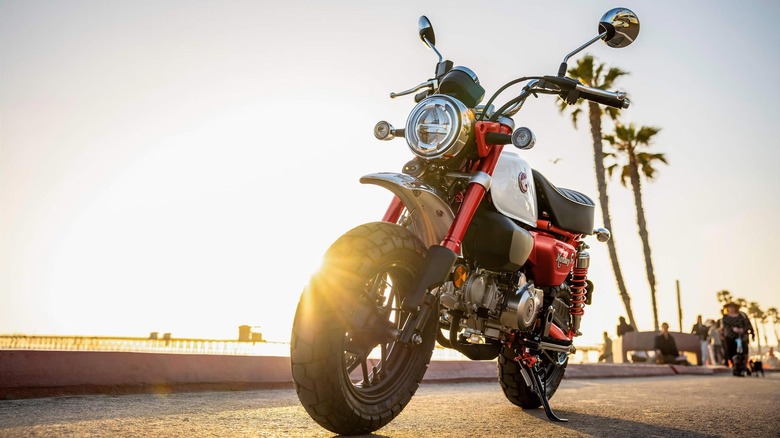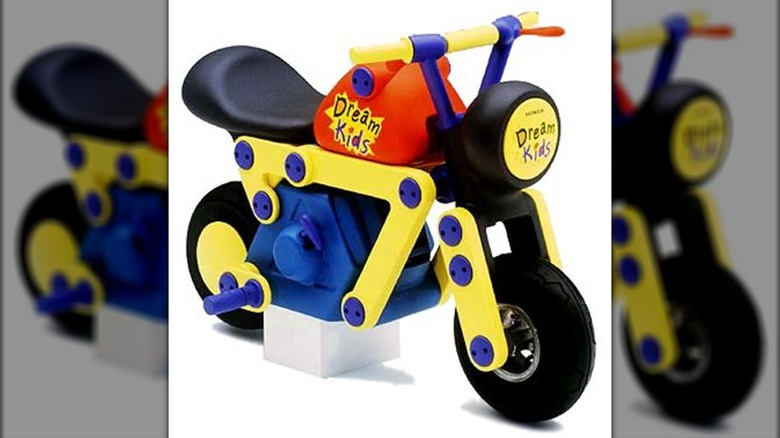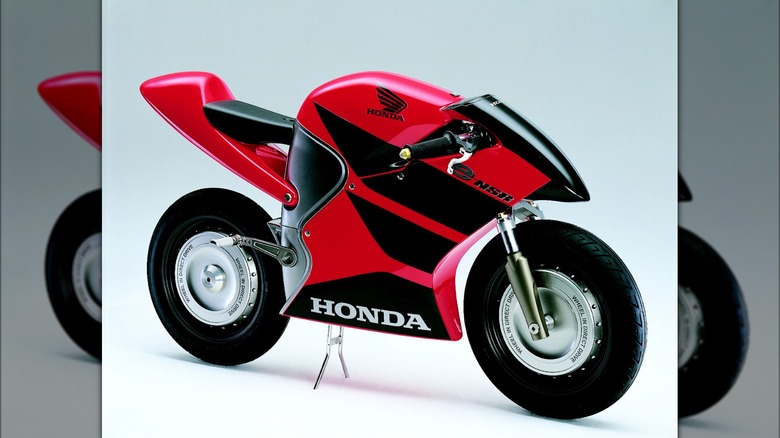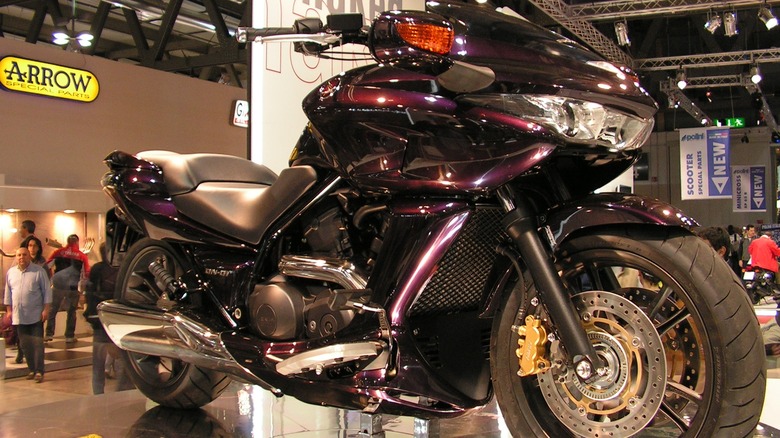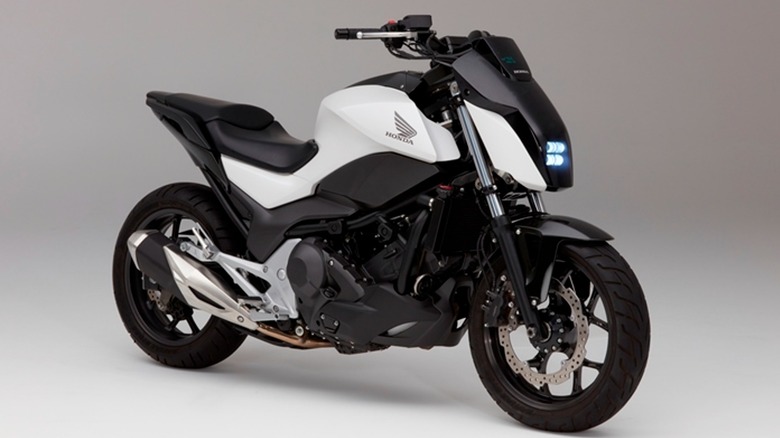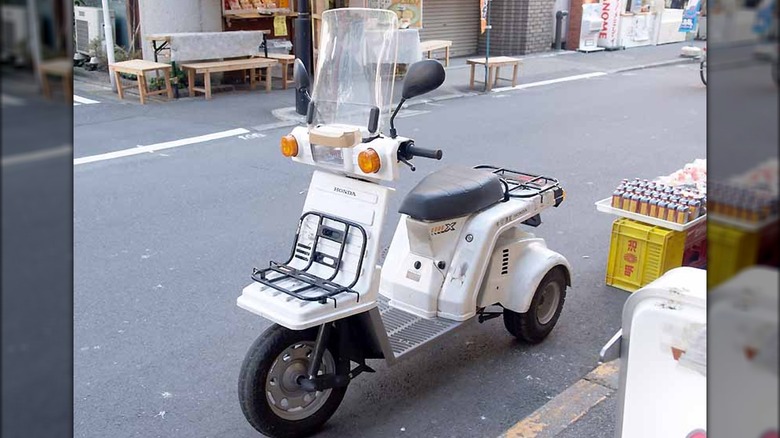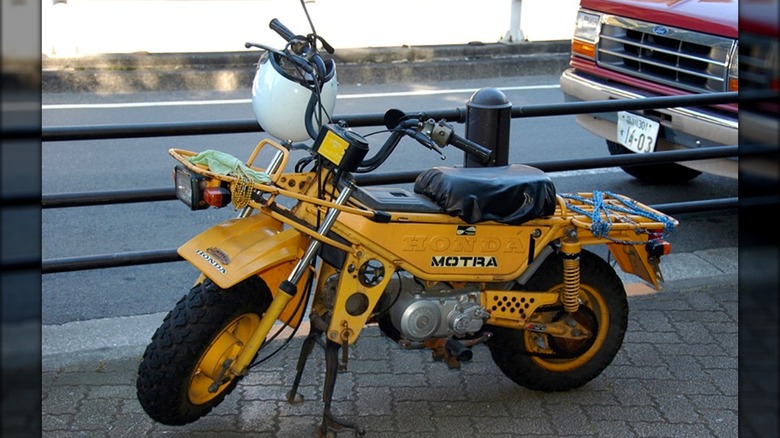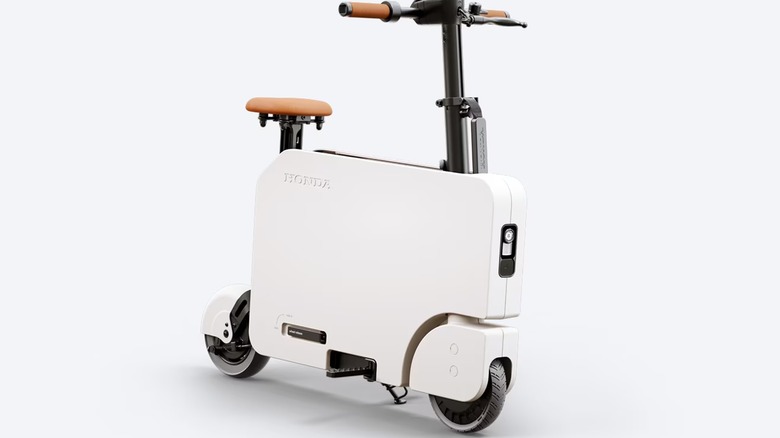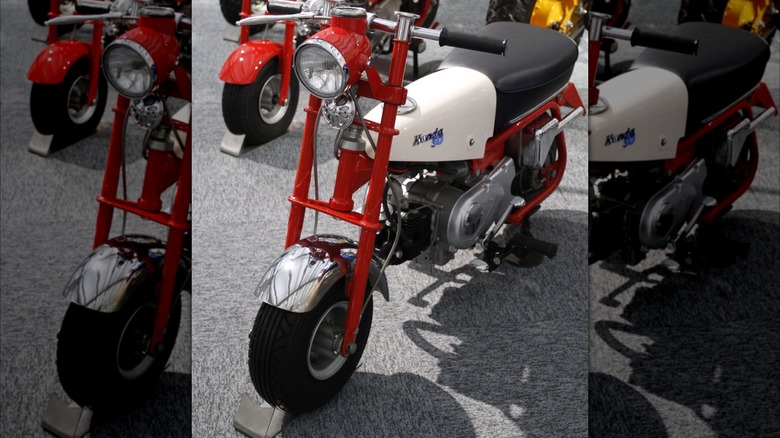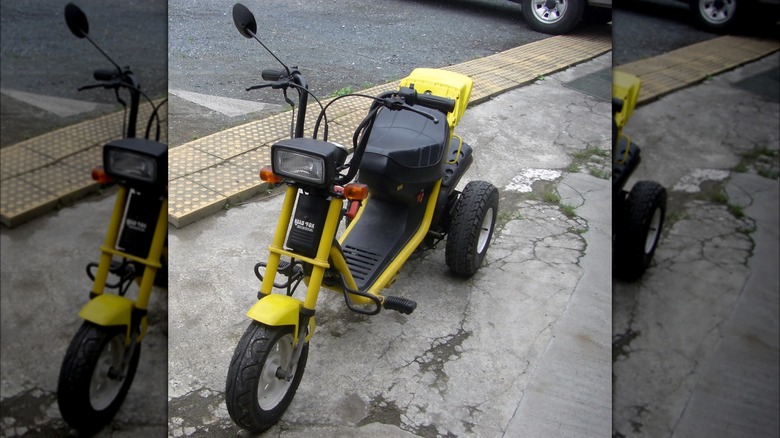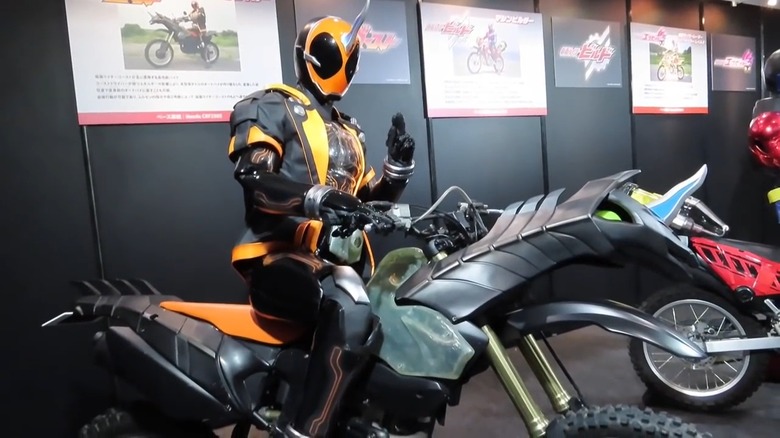10 Of The Strangest Honda Motorcycles Ever Made
Honda has been around since 1946. Technically speaking, Soichiro Honda established Tokai Seiki Heavy Industry in the 1930s. Back then, Tokai Seiki manufactured piston rings for other companies, and during World War II, Honda developed an automated process for piston ring production. After Tokai Seiki lost one manufacturing plant to a U.S. B-29 bomber attack and another to an earthquake, Mr. Honda shifted focus, eventually founding Honda Technical Research in 1946. That's when Honda started manufacturing motorcycles.
While Honda has added cars and engines to its library of products, motorcycles remain the company's bread and butter. Honda has produced numerous stylish motorcycles over the years, and plenty of Honda motorcycles have proven successful due to their quality, performance, aesthetics, or a combination of the three. But these are the bikes most Honda fans know about and associate with the company. However, Honda has also manufactured more than its fair share of unusual motorcycles. Some were bikes that looked or functioned unlike most other Hondas, while others were prototypes that never made it to production for any number of reasons. And some Honda bikes are weird because they've been customized beyond all recognition.
Dream Kids Dokitto
Odds are you might have wanted a Power Wheels when you were a kid. You were too young to drive an actual car back then, but you didn't need a license to drive a toy car. Honda had the idea to create something similar and yet, at the same time, completely different.
During the 33rd Tokyo Motor Show in 1999, Honda showed off several prototypes for concept motorcycles. Arguably, the most noteworthy exhibition was a motorcycle as unusual as it was colorful: the Dream Kids Dokitto. Even though it looked like it belonged in a toy aisle alongside a Fisher-Price car, it was a fully functioning motorcycle designed for little children.
According to the Dream Kids Dokitto's official description, Honda envisioned the bike as a DIY-styled machine that kids could assemble alongside their parents. It was intended to be powered by a DC brushed motor, though some sources claim it might have had an air-cooled, four-stroke single-cylinder engine. As if the toyetic, assembly-required design wasn't strange enough, Honda intended for the Dokitto to be modular so owners could create their own frankencycles. Or perhaps, this modularity may also have been a cost-cutting measure, as the Dokitto premiered at the motor show alongside another Honda concept — the Dream Kids Wakuccho, a go-kart with similar toy car aesthetics. While Honda produced exhibition models for both products, the Dokitto and Wakuccho never made it past that stage.
Honda e-NSR
As the popular saying goes, "start 'em young." This phrase can apply to almost any hobby so long as you have the proper equipment. Want to teach someone how to fish? Start 'em young with a fishing rod that makes casting easier and reduces the odds of accidentally hooking the user. Want to get someone addicted to motorbikes? Start 'em young with a mini motorcycle. At least, that was Honda's plan.
The Honda e-NSR was meant to be an entry in Honda's NSR line of motorcycles aimed at younger users, particularly those in urban environments. The "e" in its name wasn't a random addition; Honda wanted to outfit the motorcycle with an electric motor that was both efficient and green. At barely 2 feet tall, the e-NSR was a compact ride, complete with a storage box. And, we have to mention that the e-NSR's unique curved design made it look like a shark fin on wheels.
Like the Dream Kids Dokitto, the Honda e-NSR only appeared in prototype model form at a Tokyo Motor Show, specifically the 35th Tokyo Motor Show in 2001. The e-NSR was one of several exhaust-free electric motorcycles on display, alongside the e-DAX, MOBIMOBA, and CAIXA. Of these concepts, only the e-DAX ever made it to production. However, Honda still manufactures plenty of electric motorcycles, just none that are aimed at kids who want to ride around cities and towns.
Honda DN-01
When you try to please everyone, you might end up pleasing no one. A car cannot be spacious and compact at the same time, and you certainly can't crank up a car's speed and expect it to become one of the most fuel efficient cars of all time. Someone should have reminded Honda of this rule.
Honda's 2008 DN-01 was an odd beast, not because of its look but because of its planned features. The motorcycle was advertised as a "comfortable sports cruiser" that non-motorcyclists would enjoy. That is, of course, if you assume Honda designers knew what non-motorcyclists wanted out of a motorcycle. According to the Senior VP for Motorcycles at American Honda, the DN-01's target audiences didn't "want a scooter; they want something with the size and look of a motorcycle, but they want distinctive styling, they want a low seat height and they don't want to shift."
To achieve these goals, Honda designed the DN-01 to combine the best features of three different types of motorcycles. It aimed to be as comfortable as a cruiser, as accessible as a scooter, and as mobile as a sportbike. Plus, it featured Human Friendly Transmission, a proprietary form of continuously variable transmission that is controlled electronically. Outside of the DN-01 and EVO6 concept, you don't see Human Friendly Transmission on other bikes. However, customers were not pleased. The DN-01 was a failure because it was an oddity that tried to do too much without doing anything well.
[Featured image by Snowdog via Wikimedia Commons | Cropped and scaled | Public Domain]
Honda Riding Assist
Before you continue reading, ask yourself this: Even though you're reading an article on motorcycles, have you ever actually ridden one? If the answer is no, perhaps you don't know how to balance on one? Assuming that's the case, Honda might have a solution for you.
During the 2017 Consumer Electronics Show, Honda unveiled "Honda Riding Assist," alternatively known as the "Moto Riding Assist" technology. Less a motorcycle and more its internal mechanics, this technology is designed to help a motorcycle balance, especially while at rest — no kickstands needed. But that's not all. In the Honda Riding Assist video, you can also see the motorcycle follow a user like some two-wheeled puppy.
The first question most people would ask is just how Honda managed to make all of this work. The answer isn't gyroscopes. Instead, Honda adapted much of the balancing technology developed for the UNI-CUB, a unicycle-like personal mobility scooter. Even though the Honda Riding Assist doesn't utilize the UNI-CUB's omni-directional wheel system, the two devices share similar balancing technology. While nothing has come of the Honda Riding Assist system yet, the company is allegedly moving forward with mass production efforts. However, it is still unclear if the balancing tech will use a unique motorcycle body or be inserted into existing models.
Honda Gyro
The definition of a motorcycle is a motorized vehicle with two to three wheels, so trikes such as the Can-Am Spyder and Ryker qualify as motorcycles, as do scooters. Admittedly, it's unusual to even consider a three-wheel scooter as a motorcycle, but it's also completely factual.
At first glance, the Honda Gyro looks like a standard three-wheel scooter, albeit one that mostly has straight lines and angles instead of curves. However, once the Gyro starts moving, it immediately sets itself apart from other scooters, thanks to its tilting design. While the front wheel and seat lean to make turns, the rear wheels remain firmly planted on the ground to maintain balance.
Since the Honda Gyro was initially released in 1982, it predates most — if not all — other attempts by rival companies to produce a leaning three-wheeler. The only noteworthy exception was the Ariel 3, manufactured by the U.K. company BSA, which used a gyroscopic linkage design that Honda loved so much it licensed and adapted for the Gyro. Every Gyro vehicle and its variants, including the Gyro Canopy (aka the pizza delivery scooter), uses the same gyroscopic linkage technology. While BSA's Ariel motorcycles and scooters have been discontinued, their legacy lives on through Honda's Gyro series.
[Featured image by Comyu via Wikimedia Commons | Cropped and scaled | CC BY-SA 3.0]
CT50 Motra
Minibikes are the unsung heroes of the motorcycling world. Sure, they're small and don't have the sheer presence of standard motorcycles, but they're generally more affordable – some more affordable than others. While riding a minibike won't make you look as ridiculous as a clown riding a miniature bicycle, some minibikes definitely look weirder than most.
The CT50 Motra was an odd little duckling of a motorcycle. Despite being a 50cc minibike, it was designed with ruggedness in mind. The motorcycle featured a pipe frame body that made it look less like a bike and more like a piece of construction equipment. It also had carrier racks that could hoist far more luggage than the Motra's tiny frame would suggest. And we can't forget the minibike's giant tires or its three-speed gearbox with a two-speed stage and high and low ratios, both of which gave the Motra off-road capabilities that surpassed potential rivals.
Honda initially intended to produce 45,000 Motra units per year starting in 1982, but that's all it did; Honda ceased manufacturing one year later. Plus, nobody knows if the company even met those goals since the exact number of CT50 Motras out in the wild is a mystery. All we know is that the bike did not catch on. One possible theory helmed by Honda itself was poor timing, as Honda released the Motra during an "unprecedented motorcycle boom". The minibike could neither figuratively nor literally keep up with the "high-performance models" Japanese customers were obsessed with at the time.
[Featured image by Bit Boy via Wikimedia Commons | Cropped and scaled | CC BY 2.0]
Motocompacto
"The Jetsons" is an iconic piece of animated Americana. The show was a look into what the people of the 1960s thought the future would look like and was filled with fantastic, impossible technologies such as robotic servants, flying cars that could origami themselves into portable briefcases, and video phones. Okay, that last one is now commonplace, but we still don't have transforming flying cars. Honda does make transforming motorcycles, though.
The Motocompacto is an electric motorcycle/scooter that builds on the legacy of Honda's Motocompo. It also advances several ideas already discussed in the article, specifically those implemented in the e-NSR and other electric motorcycles displayed during the 35th Tokyo Motor Show. Like the CAIXA, the Motocompacto can condense itself to become even more portable. And whereas the e-NSR has a travel case, the Motocompacto is its own travel case. Just fold away its handlebars and seat, and the mini motorcycle becomes a compact, portable unit that can fit in many storage spaces, making it convenient for travel.
While the Motocompacto is a compact motorcycle, hence its name, it looks like a briefcase on wheels even when in motorcycle/scooter form. But despite this potential aesthetic blunder, the vehicle is still as durable as most Honda products. Plus, the Motocompacto even comes with a phone app that lets you monitor battery health and predict if the motorcycle will run out of charge before you reach your destination. And you can always customize the Motocompacto with decals to make it look less like a briefcase.
Z100 Monkey
Go-karts are a popular small-form motorsports vehicle since you don't need a driver's license to use them. You can either rent one at a racetrack or build/maintain your own, but they are far from the only recreational motorsports vehicles around. Honda once built a minibike to serve a similar purpose at amusement parks.
The Z100 Monkey looks like many other minibikes, or at least toy versions of minibikes. It has a seat, tiny wheels, and a motor on the bottom, but the Z100 Monkey sets itself apart from other minibikes — and other Honda "Monkey Bikes" — with its purpose. Unlike other Monkeys, this minicycle was never designed for commercial use.
The Monkey line of motorcycles can be traced back to the motorsports-themed Tama Tech Park. In 1961, Honda developed these petite putters for the amusement park's visitors. This isn't as surprising as it sounds since Honda owned Tama Tech Park. Patrons of another Honda-owned location, Suzuka Circuit, could also ride Z100 Monkeys. The bike proved so popular that, in 1964, Honda finally sold a street-legal version called the CZ100. In 1967, Honda sold Monkey bikes overseas, with the Z50M in Europe and the Z50A — alternatively known as the Honda Z50 Mini Trail – in the U.S. In case you're wondering why these motorcycles were known as "Monkey Bikes," apparently, people looked like monkeys when riding them.
[Featured image by baku13 via Wikimedia Commons | Cropped and scaled | CC BY-SA 2.1 jp]
Honda Road Fox
As previously stated, scooters are technically a form of motorcycle and come in a variety of shapes. The Vespa (which is still around, believe it or not) is one such example. This iconic design allegedly took inspiration from the Cushman Airborne scooter. Honda, meanwhile, drew from different sources for its motorcycles, including a beach buggy.
The Honda Road Fox was a relative of the Honda Gyro. This three-wheeled motorcycle/scooter wasn't a successor per se, but it shared a lot of design DNA with the Gyro, including the same gyroscopic linkage that allowed the front parts to tilt while keeping the rear wheels flat on the ground. So what set the Road Fox apart from the larger Gyro family? Like the CT50 Motra, the Road Fox utilized a pipe frame body, but instead of having a rugged, almost construction vehicle look, the Road Fox combined this design with a bucket seat to create a beach buggy aesthetic. However, unlike the Motra (or beach buggies), the Road Fox didn't include any luggage racks.
Unfortunately, comparisons between the Road Fox and the Motra are more than just skin-deep. Like the Motra, the Road Fox only lasted a year before Honda discontinued the motorcycle's distribution. Initially, Honda planned to manufacture 18,000 units, but again, we don't really know if the company met that goal, let alone how many Road Foxes are left. Pipe frame bodies just didn't seem to agree with the Japanese motorcycle/scooter consumer base.
[Featured image by Kuha455405 via Wikimedia Commons | Cropped and scaled | CC BY-SA 3.0]
Multiple Kamen Rider Bikes
Building sci-fi vehicles for movies or TV shows can be easy ... relatively speaking. You start with a base car or bike, attach parts to change the look, and of course, hire someone to help with the work. But when you have to repeat this process for seasons upon seasons without end, you might find yourself turning to a reliable source for customizable vehicles.
The "Kamen Rider" franchise is a cornerstone of Japanese entertainment, debuting in 1971 with a grasshopper-themed vigilante who fights rubber-suited monsters while riding a motorcycle. Each season, a new hero appears with a fresh theme, gimmick, and motorcycle, requiring new costumes, props, and, most importantly, motorcycles every year. At first, producers relied on Suzuki machines, but as of the year 2000, they have almost exclusively used Hondas.
Depending on the theme and gimmick, bike customizations range from coats of paint to full-on conversions. One of the more notable Honda motorcycles used is a Honda X4 in "Kamen Rider Agito," where the hero is a mechanized cop — the bike's front boldly displays "Police" and "Honda" in black letters. But then there are seasons like "Kamen Rider Ghost," where a Honda CRF250X becomes a phantasmal unicorn. The only semi-modern "Kamen Rider" series that didn't prioritize using a Honda motorcycle was "Kamen Rider Drive," if only because the protagonist drove a modified Honda NSX– a car, not a motorcycle.
